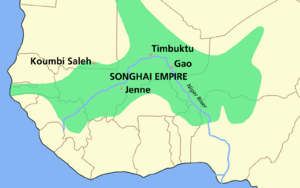Askia Muhammad I facts for kids
Quick facts for kids Askia Muhammad |
|||||
|---|---|---|---|---|---|
| Ruler of the Songhai Empire | |||||
| Reign | April 1493 – 1528 | ||||
| Predecessor | Sunni Baru | ||||
| Successor | Askia Monzo Mūsā | ||||
| Born | c. 1443 Gao |
||||
| Died | c. 1538 (aged 94–95) Gao Songhai Empire |
||||
| Burial | Tomb of Askia Gao Mali |
||||
| Issue | Askia Musa, Askia Isma'il, Askia Ishaq I, Askia Dawud, hawah, Fatimatu and 465 other children | ||||
|
|||||
| Dynasty | Askia dynasty | ||||
| Father | Abi Bakr | ||||
| Mother | Kassey | ||||
| Religion | Sunni Islam | ||||
Askia Muhammad I (born around 1443, died around 1538) was a powerful ruler of the Songhai Empire in West Africa. His birth name was Muhammad ibn Abi Bakr al-Turi. He is often called Askia the Great because he made the Songhai Empire the largest and most powerful empire in West African history. He ruled from 1493 to 1528.
Under Askia Muhammad's leadership, the Songhai Empire grew very large. It stretched from Taghaza in the north to Yatenga in the south. It also went from Air in the northeast to Futa Djallon in Guinea. He improved trade with Europe and Asia. He also created many schools and made Islam an important part of the empire.
Muhammad was a skilled general for the previous Songhai ruler, Sonni Ali. After Sonni Ali died in 1492, his son, Sunni Baru, became ruler. Muhammad believed Sunni Baru was not a good Muslim leader. So, he challenged him and won. Muhammad became the new ruler in 1493.
Askia Muhammad set up a strong government. He created a system of officials to help him rule. He also made trade fair by setting standard rules. He made sure trade routes were safe. He also created an organized tax system. Later, in 1528, his son, Askia Musa, took over his rule.
Who Was Askia Muhammad?
Askia Muhammad was born in Gao, a city in the Songhai Empire. His father, Baru Lum, came from the Toucouleur or Soninke people. His mother, Kassey, was said to be the sister of the previous ruler, Sonni Ali.
The title "Askia" means "it is not his" or "he shall not be it." This name comes from a story about Sonni Ali's daughters. They supposedly said this when they learned Muhammad had taken power. After a special trip to Mecca (called the hajj) in 1497–1498, he was also known as Askia al-Hajj Muhammad. In modern Songhai, people call him Mamar Kassey. "Mamar" is a form of Muhammad, and "Kassey" comes from his mother's name.
Askia's Family and Legacy
Askia Muhammad had a very large family. Historical texts say he had 471 children from many wives. Like famous leaders such as Genghis Khan and Charlemagne, Askia Muhammad has many descendants today. His family members are found across several countries where the Songhai people live. They often hold important positions like village chiefs.
Many of his descendants are known as the "Mamar Haamey." They founded powerful kingdoms in places like Niger. They often fought against other groups like the Tuareg and Fulani. They also fought against French colonization.
Another group of his descendants are the "Songhai Djermas." They are related to the earlier Za and Sunni dynasties. Marriages between these royal families were common. This created strong family ties among them. The Djerma and Mamar Haamey consider themselves one big family. They often supported each other in times of war.
Askia Muhammad also had family ties with the Hausa people. His daughter, Awah, married Muhammad Rumfa, the Sultan of Kano. This means many Hausa rulers in Kano were related to Askia Muhammad through their mothers.
Even the Arma people, who are descendants of Spanish soldiers and Songhai women, often have family links to Askia Muhammad. Today, millions of people in the Central Sahel region might be related to Askia Muhammad.
The Tomb of Askia in Gao is believed to be his burial place. It is a UNESCO World Heritage Site.
Askia's Achievements
Askia Muhammad greatly valued learning and education. He made sure that Songhai's universities produced many brilliant scholars. These scholars wrote important books. One famous scholar was his nephew, Mahmud Kati.
Askia Muhammad worked closely with the scholars of Timbuktu. This led to a "golden age" for the city. It became a center for science and Islamic learning. Famous scholars like Ahmad Baba al Massufi wrote books on Islamic law that are still used today.
Two important history books, Tarikh al-fattash and Tarikh al-Sudan, were written during this time. These books help historians understand African history from the Middle Ages.
See also
 In Spanish: Askia Mohamed I el Grande para niños
In Spanish: Askia Mohamed I el Grande para niños
- Legends of Africa


